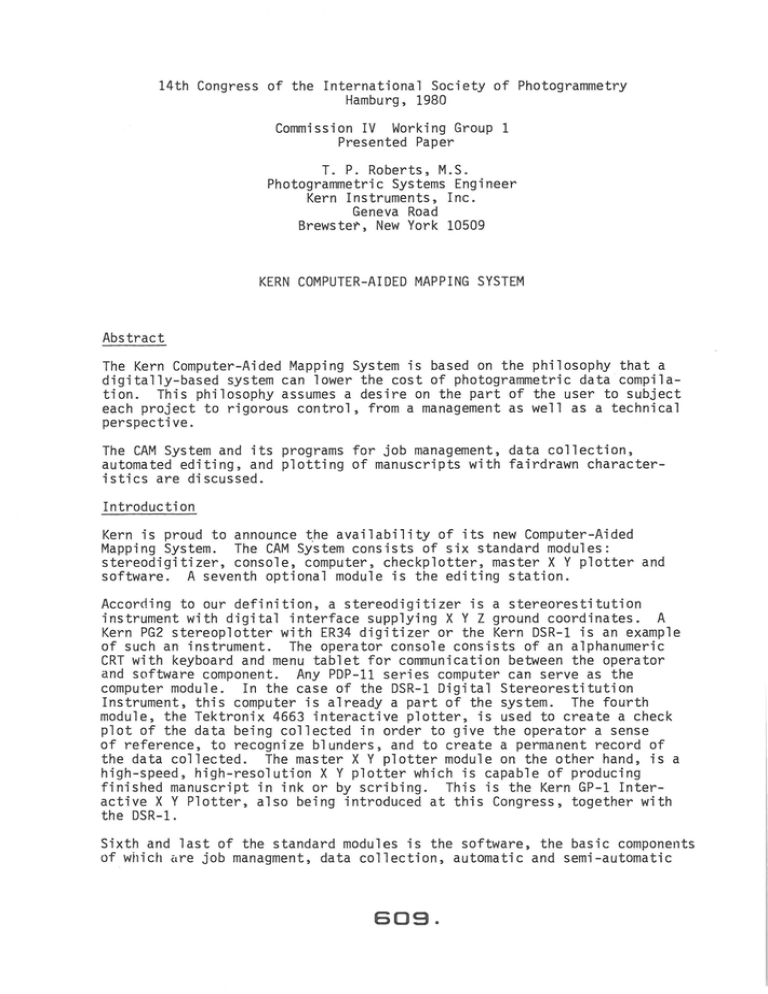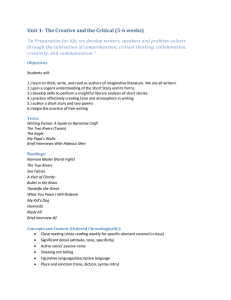14th International 1980 IV Working
advertisement

14th Congress of the International Society of Photogrammetry Hamburg, 1980 Commission IV Working Group 1 Presented Paper T. P. Roberts, M.S. Photogrammetric Systems Engineer Kern Instruments, Inc. Geneva Road Brewstet, New York 10509 KERN COMPUTER-AIDED MAPPING SYSTEM Abstract The Kern Computer-Aided Mapping System is based on the philosophy that a digitally-based system can lower the cost of photogrammetric data compilation. This philosophy assumes a desire on the part of the user to subject each project to rigorous control, from a management as well as a technical perspective. The CAM System and its programs for job management, data collection, automated editing, and plotting of manuscripts with fairdrawn characteristics are discussed . Introduction Kern is proud to announce the availability of its new Computer-Aided Mapping System. The CAM System consists of six standard modules: stereodigitizer, console, computer, checkplotter, master X Y plotter and software. A seventh optional module is the editing station . According to our definition, a stereodigitizer is a stereorestitution instrument with digital interface supplying X Y Z ground coordinates . A Kern PG2 stereoplotter with ER34 digitizer or the Kern DSR-1 is an example of such an instrument. The operator console consists of an alphanumeric CRT with keyboard and menu tablet for communication between the operator and software component . Any PDP -11 series computer can serve as the computer module. In the case of the DSR-1 Digital Stereorestitution Instrument, this computer is already a part of the system . The fourth module, the Tektronix 4663 interactive plotter, is used to create a check plot of the data being collected in order to give the operator a sense of reference, to recognize blunders, and to create a permanent record of the data collected. The master X Y plotter module on the other hand, is a high-speed, high-resolution X Y plotter which is capable of producing finished manuscript in ink or by scribing. This is the Kern GP-1 Interactive X Y Plotter, al so being introduced at this Congress, together with the DSR-1 . Sixth and l ast of the standard modules is the software, the basic components of which are job managment, data col l ection, automatic and semi -automatic 609. editing, and plotting. The optional editing station consists of the Kern - Contraves Model IGS 7000 Interactive Graphics System, which will be the subject of another paper . A digitizing tablet-based editing package is also being readied for customers with a minimum of editing requirements. CAM System Philosophy The basic premise behind the development of the CAM System is that today, even for projects where no digital data base is required, a digital plani metric mapping system is cost-effective for large-scale projects . This has been carried out by providing for the first time a comprehensive project management and data collection package, which is tailored to the needs and budget of the great majority of mapping firms involved in largescale mapping projects . It is tailored for easy use following the traditional method of map making, while at the same time allowing sophisticated automated and semi-automated ed iting and plotting of collected data. The philosophy assumes a desire on the part of the user to subject each project to rigorous control, from a managment as well as technical perspective . This means essentially, rigorous analytical triangulation, together with a good job management program . Why should these items take preference over discussion of data collection, editing and plotting? Because it is our contention that this, or any digital mapping system, will not be a viable alternative to traditional methods unless such rigorous control is established . Analytical Aerotriangulation With the recent advancement in the availability of analytical aerotriangulation software for mini-computers, there is no reason for any organization cons i dering digital mapping not to have access to a bundle adjustment program. Furthermore, the advantages, even for small jobs, are overwhelming . Absolute orientation of each model is simplified, since all control points are known to be good. Model ties are also known in advance to be good, so that problems will not arise when joining models into manuscripts. A third advantage is the time savings which will surely result from being freed of these typical problems. Upon completion of the bundle adjustment, the results are entered into the job management section of the CAM system for later use during the data collection and plotting phases. Job Management Program We find that job management is the most important single program in the software module. This is where the job specifications are set down, including accuracy requirements, line and symbol types, and manuscript distribution. It is also used to keep the record of ground point coordinates, job boundaries and size, and other general information relating to the job at hand. 6:1.0. All standard manuscript gridding layouts can be accommodated automatically, including placement of grid labeling, if any. In addition, each manuscript can be individually edited as desired. Once the relevent information has been entered, plots of manuscripts with ground control points, title block, grids, etc. can be produced to show the customer what the product will look like . Even job boundaries and a legend can be plotted showing each of the symbols and line types selected for the particular job. Armed with the data provided by the job management program, including results of the bundle adjustment and the customer's approval of preliminary manuscripts, the digital stereocompilation can begin in earnest. Data Collection Each of the CAM programs uses a menu system to provide the most operatorfriendly environment possible. A CRT displays the current choices for selection by the operator, while a menu tablet is used to select the operator's responses. During data collection, however, each of the many possible choices for line or symbol type need not be displayed. Instead, the operator's tablet allows him to choose any of 64 possible line types and an equal number of symbols. This command is acknowledged on the CRT by display of an appropriate message. A written description of the line or symbol type appearing on the menu tablet makes this process very simple. There are two commands, however, which the operator uses so often that even more operator convenience is required. These are pen-up and pen-down commands, and a command to choose between continuous curved lines or straight lines. The first are provided in the form of two footpedals; the right footpedal is for data collection with pen-down movement, and the left for pen-up motions. The curve-straight line selection is done by means of a toggle switch placed within easy reach of the operator. The information regarding the use of these facilities is transmitted to the computer as part of the data record from the ER34 digitizer, or DSR-1 Stereorestitution Instrument. When a mistake is made, the operator can merely shift the program into reverse, so to speak, and erase data going backwards from the present location as far as he wishes. Both the collected and erased data will be shown on the checkplot, which is located conveniently for viewing and writing notes or questions he may have. In this way, a permanent record is created during the collection phase. The operator may also select, at random, data items to be removed from the file by pointing the checkplot cursor to the desired item. This method of data collection allows the operator to concentrate on what he does best without the need to make cartographic decisions, or to spend much time in the editing process. Edit Program Two editing stations will be available for the CAM System. The KernContraves IGS 7000 Interactive Graphics Station, and a tablet-based station. Right now, only the Interactive System is available. 611. Very soon, however, the tablet-based station will be announced. It will consist of map-sized digitizing tablet upon which the map is placed. Instead of the usual highly interactive systems, however, only typical map editing functions will be available. As an example, to clean up a "T" intersection which is not quite perfect, the operator would enter the command, followed by touching the map location of the intersection with the tablet cursor. The files will be automatically updated to reflect the change before the next plot is requested. Of course, addition, deletion, and many other functions will be available. This allows fast and easy editing of data, in a fashion similar to traditional methods. Plotting Programs Kern•s CAM System plotting software consists of two separate programs: one for automatic plot file preparation, and another for driving the master X Y plotter using data stored in the plot file. The automatic editing program combines data from several models, automatically joining lines which cross the edge. It also squares buildings and joins lines where applicable, according to parameters set down by the program operator. The data will be automatically windowed as appropriate. The plot program transmits the data from the plot file to the master X Y plotter. This is an interactive program which requires an operator to be in attendance to answer queries from the program relating to change of pen or scribe tools, as required. The resulting plot will contain all cosmetic enhancements specified during the automatic editing phase. It may also be used, though, to create a fast plot at final scale before beginning the edit phase. This will show the editor any blunders which remain in the fi 1e. Our aim as present is to create a final plot with the fairdrawn characteristics of manual drafting, but with a higher accuracy . Nevertheless, it will probably never be possible to create a computer system which does not require some touching up of manuscripts. Summary From a comprehensive job management program through final plot, the CAM System has been designed to improve productivity in map making while providing an enviromnet of unexcelled operator-friendliness. Automated editing provides the cosmetcs necessary to produce acceptable maps without operator intervention, and the plotting program allows the utmost flexibility in the use of various line widths and ink colors . Although all programs are not yet complete, we do have a working system which shows great potential for bringing our system philosophy to fruition. 6:1.2.



